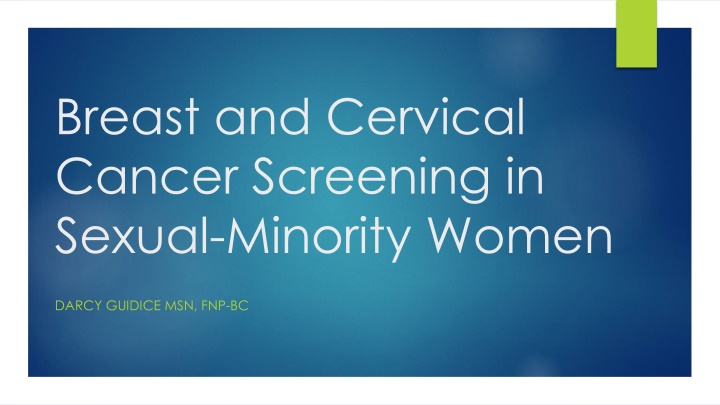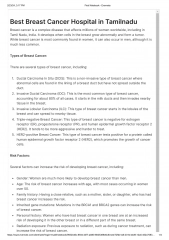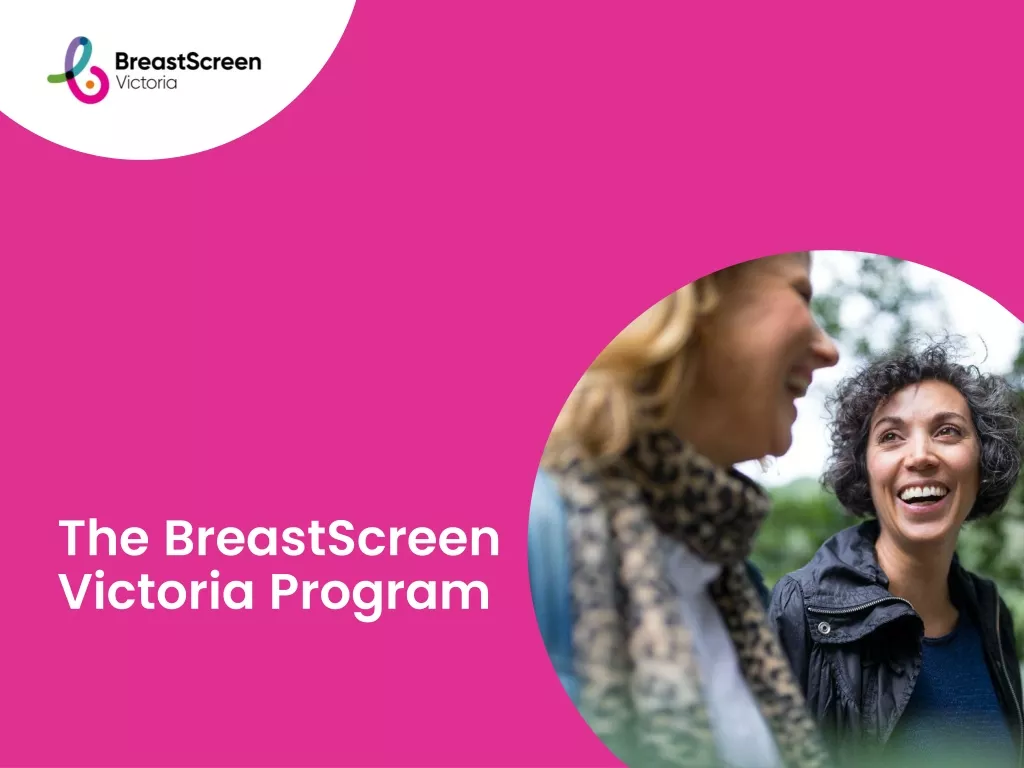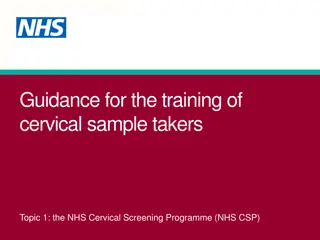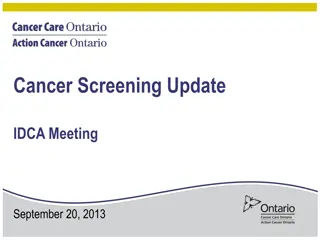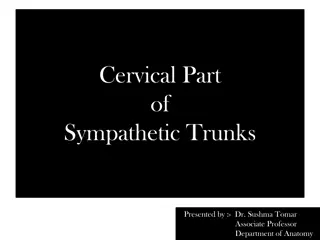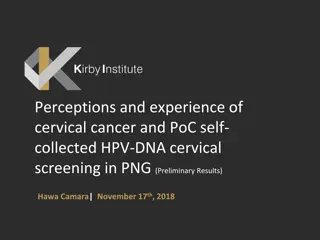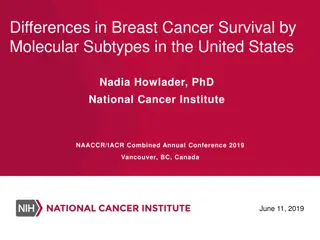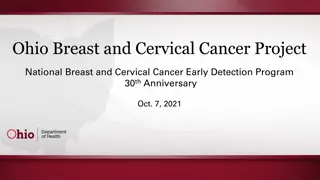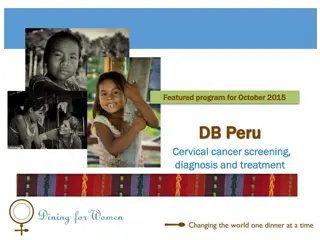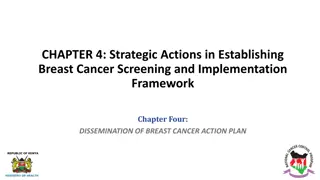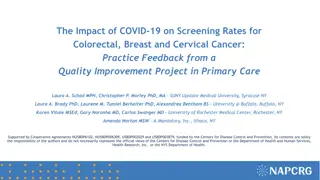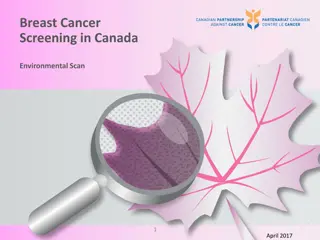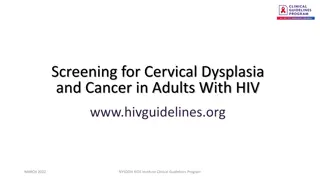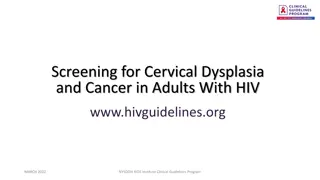Breast and Cervical Cancer Screening in Sexual-Minority Women: Barriers and Implications
Access to appropriate healthcare is a pressing concern for sexual-minority women, with barriers such as knowledge gaps, stigma, and limited insurance coverage affecting timely breast and cervical cancer screening. The National LGBT population estimates, coupled with lower screening rates due to the COVID-19 pandemic, underline the importance of addressing these disparities to prevent higher cancer rates and mortality in this demographic.
Download Presentation

Please find below an Image/Link to download the presentation.
The content on the website is provided AS IS for your information and personal use only. It may not be sold, licensed, or shared on other websites without obtaining consent from the author.If you encounter any issues during the download, it is possible that the publisher has removed the file from their server.
You are allowed to download the files provided on this website for personal or commercial use, subject to the condition that they are used lawfully. All files are the property of their respective owners.
The content on the website is provided AS IS for your information and personal use only. It may not be sold, licensed, or shared on other websites without obtaining consent from the author.
E N D
Presentation Transcript
Breast and Cervical Cancer Screening in Sexual-Minority Women DARCY GUIDICE MSN, FNP-BC
Introduction Access to appropriate healthcare is a pressing concern across many populations Barriers to care vary between populations Barriers to care include: knowledge, education, associated stigma, and access to insurance (Kerker et.al., 2006, Smith et.al., 2017)
Introduction The National LGBT population estimates are as follows: Flores, A.R. & Conron, K.J. (2023). Adult LGBT Population in the United States. The Williams Institute, UCLA, Los Angeles, CA
Background The body of research regarding women s health as a separate entity is much small than that of men s health Specifically identifying women who identify as non-heterosexual further narrows the available research Much of the currently available literature indicates that larger scale population-based studies would bolster the current understanding of the demographic and their associated health behaviors (Haviland et. al., 2020).
Significance According to the CDC in 2020 the rate of new cervical cancers was 7 per 100,000 women and the rate of new breast cancers was 119.2 per 100,000 women (CDC, 2024). The CDC does indicate that these rates are lower than previous years due to barriers associated with care access and fewer screening opportunities related to the COVID-19 pandemic. Problems with screening have been identified within this population and the implications for the population are related to possible higher rates of breast and cervical cancer along with the possibility of increased mortality when compared to their heterosexual counterparts. (Solazzo et. al, 2017)
Clinical Question What are the barriers to timely and appropriate breast and cervical cancer screening in sexual-minority women with intact cervixes aged 21- 65?
Literature Review A review of the literature was conducted using University of Detroit Mercy s library access. The literature review returned results ranging in date from 2006-2023. The search terms used include: cervical cancer screening, breast cancer screening, LGBT, lesbian, lesbian women.
Purpose Statement The purpose of this project is to better understand breast and cervical cancer screening habits as well as beliefs and knowledge or lack thereof in sexual-minority identifying women with intact cervixes. The goal of the project is to gain an understanding of how education, economic stability, environment, healthcare and social context impact access to appropriate healthcare. (Health People 2030)
Theoretical Framework The Social Determinants of Health framework cites the importance that education, economic stability, environment, healthcare, and social context have on access to appropriate healthcare It intersects with the Minority Stress Model in that they both take into consideration the effect that environment, education and social context have on people who identify as part of this population. Both are commonly used in the context of the LGBT community.
Theoretical Framework
Theoretical Framework The Minority Stress Model specifically addresses the needs of the Lesbian Gay and Bisexual (LGB) population and was originally developed with the LGB population in mind. - The Minority Stress Model within the context of the LGB community is well researched and multiple studies exist which have demonstrated the efficacy of the model on the study LGB issues (Meyer, 2003; Frost et. al., 2015., IOM, 2011). -
Organizational Assessment A convenience sample from the population of interest was obtained from women that are affiliated with an adult hockey league in the Metro Detroit area. This league operates under the governance of USA Hockey. It is a national organization that maintains ice hockey standards of play across the United States
IRB IRB approval was obtaining prior to opening and disseminating survey Stakeholder (USA Hockey Affiliate) approval was obtained
Methods/Design The project design was a needs assessment of sexual minority women with intact cervixes ages 21-65 This project assessed the barriers to appropriate and timely breast and cervical cancer screening as described by this community. The needs assessment was obtained using an anonymous SurveyMonkey. The goal of the tool was to better understand what barriers this community may face regarding breast and cervical cancer screening. The survey consists of demographic questions as well as questions found in the literature using a similar population. (Barefoot et. al 2017, Curmi et. al 2015, Haviland et. al 2020, Pascheen-Wolff et. al 2020, Shetty et. Al 2016)
Methods and Design
Methods and Design The board of the USA Hockey affiliate league was a key informant and helped with dissemination by sharing the study with their subscribers. The study gained most of its responses using the Snowball method and word of mouth to collect and convenience sample. This is an incredibly close community and there was much discussion and gratitude for the work being done with this study. Ethical considerations for this project were minimal. The survey was fully voluntary, and all results obtained from the survey remain completely anonymous.
Data Analysis Inferential statistical tests were used to determine if the data from the study aligned with what is expected by chance alone. The results allowed conclusion to be drawn about the sample. Chi-square and Fischer s exact test were used to understand significance between variables in >50 total comparison tests.
Results The data from this population does not conform to findings from previous studies Of the 51 total statistical tests run, a large majority were not found to indicate significant relationships between variables. Only 8 of the 51 tests indicated significance. Overall the findings of this project did not produce expected results based on themes found in the literature which include fear, behavioral risk factors, and access to care.
Income Demographics Indicate your tax bracket if single:
Income Demographics Indicate your tax bracket if married:
Insurance Demographics Which of the following applies to you regarding your insurance or medical coverage?
Results The data to the right is an example of a chi square test that shows significance between Ethnicity and previously having a cervical pap smear. The table indicates a significant relationship between variables and suggests that different ethnic groups show different patterns of pap smear utilization.
Themes outlined by the literature review included: Behavioral risk factors: The literature indicates that sexual minority women has a higher-than-average rate of smoking, alcohol use and unhealthy weight. Smoking: National prevalence: 10.1% of women report smoking everyday or some days (CDC, 2021) Study sample: 14% of the study sample report smoking every day or some days Alcohol use: Discussion National prevalence: 4.5% of women 18 and older consume 8 or more drinks per week (NIAAA, 2024) Study sample: 5.66% of sample report drinking 6 or more drinks per week Obesity: National prevalence: 81% of women over the age of 20 are overweight or obese (CDC, 2024) Study sample: 48.57% of sample report being told they are overweight or obese by their healthcare provider
Discussion Fear The literature review indicated that heteronormative assumption, stigma or perceived stigma, and outright hostility toward sexual minority women is a barrier to appropriate screening behaviors in this population. The survey for this project indicates 60.37% disagree or strongly disagree with the statement that healthcare providers lack of knowledge on LGBT issues would impact their decision to have a mammogram and 57.54% indicate that lack of provider knowledge of LGBT issues would impact their decision to have a pap smear 79.24% of women surveyed reported they feel comfortable discussing breast health with their healthcare provider 78.3% of women surveyed reported they feel comfortable discussing cervical health with their healthcare provider Access to care 82.08% of those surveyed have an established primary care provider and 56.6% have an established OB/GYN or Midwife. In 2022 The U.S Census Bureau found that 89.2% of American adults 19-64 were insured. This is 10% less than the data from the surveyed sample indicates. (Census, 2023) 99.5% have some form of health insurance compared to 89.2% for the National average (Kiesler-Starkey et., al, 2022)
Discussion Access to care The literature indicates that sexual and gender minorities generally do have limited access to affirming, culturally competent care which affects health outcomes within the population. (Gagnon et. al., 2022) 82.08% of this population have an established primary care provider and 56.6% have an established OB/GYN or Midwife. 99.5% have some form of health insurance compared to 89.2% for the National rates (Kiesler-Starkey et., al, 2022)
Discussion Level of Formal Education According to the U.S. Census Bureau 39% of women aged 25 and older held a bachelors degree or higher in 2022 (Census, 2023). For this sample 69.81% had a bachelors degree or higher in 2023. Median income in the United states for a single female is $40,200 (Census Income, 2023) 58.46% of this population are above this median income level when they reported their income as a single female. Sustainability and Dissemination The intention is to share these findings and the interpretation of the findings with stakeholders and those who completed the survey. Community members who were not able to participate in the survey have also requested to be informed outcomes. There is hope to share these findings academically as they are further developed.
Discussion Outcomes and Dissemination Based on the findings of the survey, healthy lifestyle education is a way to positively impact this population. As previously discussed, the population of this survey had higher rates of smoking and alcohol use when compared to the general adult population in America. The survey findings also indicate that continued improvement in education of healthcare providers is way to increase comfort in obtaining healthcare. Both of these areas provide opportunity to improve wellness and increase preventative screening within the study population. The results of the survey will be shared with the organization that assisted with the dissemination of the survey and assisted with obtaining anonymous participants. That infographic will be available at the end of this presentation
Discussion One positive finding within this population was that a notable number of participants felt happy with their providers and felt their healthcare needs were being clearly heard.
Discussion Weaknesses: After analysis of the question format and the results of the survey there were some clear weaknesses that would be rectified if this project were to be replicated. The removal of the neutral response would help provide more clear answers throughout the survey. o The wording of some questions should also be changed to read more clearly and get a concise answer from the participants. o With the addition of some edits this survey can be replicated and used to obtain data on a more diverse population as opposed to the current population skewed heavily toward Caucasian, with higher educational achievement and higher income than the average American woman. o
Discussion Implications The current political environment in the United States is concerning for the continued health and well being of sexual minority women. There is increased hostility to those who may not visibly conform to gender and social norms for example the Safety of Public Spaces Act signed into law in Florida which allows people to be charged with trespassing for entering a bathroom that does not align with their birth gender. This is one example of legal action that may negatively impact the continued protections of sexual minority people. Continued political pressure and perceived or actual hostility are all compelling reasons to continue the dissemination and education on topics such as those discussed in this project.
Thank You Committee I would like to thank my Committee, Dr. Serowoky and Dr. Stewart for their time, dedication and expertise on the development and implementation of my project. Your patience through this process was very much appreciated.
References The American Association of Colleges of Nursing (AACN) homepage. (n.d.). Retrieved October 19, 2022, from https://aacnnursing.org/Portals/42/Publications/DNPEssentials.pdf Barefoot, K. N., Warren, J. C., & Smalley, K. B. (2017). Women s Health Care: The experiences and behaviors of rural and urban lesbians in the USA. Rural and Remote Health, 17(1). https://doi.org/10.22605/rrh3875 Biddell, C. B., Spees, L. P., Smith, J. S., Brewer, N. T., Des Marais, A. C., Sanusi, B. O., Hudgens, M. G., Barclay, L., Jackson, S., Kent, E. E., & Wheeler, S. B. (2021). Perceived financial barriers to cervical cancer screening and associated cost burden among low-income, under-screened women. Journal of Women's Health, 30(9), 1243 1252. https://doi.org/10.1089/jwh.2020.8807 Centers for Disease Control and Prevention. (2022, September 13). United States Cancer Statistics. Centers for Disease Control and Prevention. Retrieved September 28, 2022, from https://www.cdc.gov/cancer/uscs/index.htm Centers for Disease Control and Prevention (2024, March 28). Current Cigarette Smoking Among Adults in the United States. Retrieved March 28, 2024 from https://www.cdc.gov/tobacco/data_statistics/fact_sheets/adult_data/cig_smoking/index.htm Centers for Disease Control and Prevention. (2024, March 28). Prevalence of Overweight, Obesity, and Severe Obesity Among Adults Aged 20 and Over: United States, 1960 1962 Through 2017 2018. Retrieved March 28, 2024, from https://www.cdc.gov/nchs/data/hestat/obesity-adult-17-18/obesity-adult.htm#table1 Cochran, S. D., & Mays, V. M. (2012). Risk of breast cancer mortality among women cohabiting with same sex partners: Findings from the National Health Interview Survey, 1997 2003. Journal of Women's Health, 21(5), 528 533. https://doi.org/10.1089/jwh.2011.3134 Curmi, C., Peters, K., & Salamonson, Y. (2015). Barriers to cervical cancer screening experienced by Lesbian women: A qualitative study. Journal of Clinical Nursing, 25(23-24), 3643 3651. https://doi.org/10.1111/jocn.12947
References Flores, A.R. & Conron, K.J. (2023). Adult LGBT Population in the United States. The Williams Institute, UCLA, Los Angeles, CA Frost, D. M., Lehavot, K., & Meyer, I. H. (2015). Minority stress and physical health among sexual minority individuals. Journal of behavioral medicine,38(1), 1 8. https://doi.org/10.1007/s10865-013-9523-8 Gagnon KW, Bifulco L, Robinson S, et al Qualitative inquiry into barriers and facilitators to transforming primary care for lesbian, gay, bisexual and transgender people in US federally qualified health centresBMJ Open 2022;12:e055884. doi: 10.1136/bmjopen-2021-055884 Haviland, K., Swette, S., Kelechi, T., & Mueller, M. (2020). Barriers and facilitators to cancer screening among LGBTQ individuals with cancer. Oncology Nursing Forum, 47(1), 44 55. https://doi.org/10.1188/20.onf.44-55 Institute of Medicine (US) Committee on Lesbian, Gay, Bisexual, and Transgender Health Issues and Research Gaps and Opportunities. (2011). The Health of Lesbian, Gay, Bisexual, and Transgender People: Building a Foundation for Better Understanding. National Academies Press (US). Johnson, M. J., Mueller, M., Eliason, M. J., Stuart, G., & Nemeth, L. S. (2016). Quantitative and mixed analyses to identify factors that affect cervical cancer screening uptake among lesbian and bisexual women and transgender men. Journal of Clinical Nursing, 25(23-24), 3628 3642. https://doi.org/10.1111/jocn.13414 Johnson, M. J., Nemeth, L. S., Mueller, M., Eliason, M. J., & Stuart, G. W. (2016). Qualitative study of cervical cancer screening among lesbian and bisexual women and transgender men. Cancer Nursing, 39(6), 455 463. https://doi.org/10.1097/ncc.0000000000000338 Kiesler-Starkey, K., Bunch, L., & Lindstrom , R. (n.d.). Health insurance coverage in the United States: 2022. Health Insurance Coverage in the United States: 2022. https://www.census.gov/content/dam/Census/library/publications/2023/demo/p60-281.pdf Kerker, B. D., Mostashari, F., & Thorpe, L. (2006). Health Care Access and utilization among women who have sex with women: Sexual behavior and identity. Journal of Urban Health, 83(5), 970 979. https://doi.org/10.1007/s11524-006-9096-8 Matthews, A. (2004). Correlates of underutilization of gynecological cancer screening among lesbian and heterosexual women. Preventive Medicine, 38(1), 105 113. https://doi.org/10.1016/j.ypmed.2003.09.034 Mountjoy, M., Brackenridge, C., Arrington, M., Blauwet, C., Carska-Sheppard, A., Fasting, K., Kirby, S., Leahy, T., Marks, S., Martin, K., Starr, K., Tiivas, A., & Budgett, R. (2016). International Olympic Committee Consensus statement: Harassment and abuse (non- accidental violence) in sport. British Journal of Sports Medicine, 50(17), 1019 1029. https://doi.org/10.1136/bjsports-2016-096121
References National Institute on Alcohol Abuse and Alcoholism (2024, March 28). Alcohol Use in the United States: Age Groups and Demographic Characteristics. Retrieved March 28, 2024 from https://www.niaaa.nih.gov/alcohols-effects-health/alcohol-topics/alcohol-facts-and- statistics/alcohol-use-united-states-age-groups-and-demographic-characteristics Paschen-Wolff, M. M., Greene, M. Z., & Hughes, T. L. (2020). Sexual minority women s sexual and Reproductive Health Literacy: A qualitative descriptive study. Health Education & Behavior, 47(5), 728 739. https://doi.org/10.1177/1090198120925747 Shetty, G., Sanchez, J. A., Lancaster, J. M., Wilson, L. E., Quinn, G. P., & Schabath, M. B. (2016). Oncology Healthcare Providers knowledge, attitudes, and practice behaviors regarding LGBT health. Patient Education and Counseling, 99(10), 1676 1684. https://doi.org/10.1016/j.pec.2016.05.004 Smith, S. K., & Turell, S. C. (2017). Perceptions of healthcare experiences: Relational and communicative competencies to improve care for LGBT people. Journal of Social Issues, 73(3), 637 657. https://doi.org/10.1111/josi.12235 Solazzo, A. L., Gorman, B. K., & Denney, J. T. (2017). Cancer screening utilization among U.S. women: How mammogram and pap test use varies among heterosexual, lesbian, and bisexual women. Population Research and Policy Review, 36(3), 357 377. https://doi.org/10.1007/s11113-017-9425- 5 SportsEngine. This is USA hockey. (2022). https://www.usahockey.com/about United States Census Bureau (2024, March 28). Census Bureau Releases New Educational Attainment Data. Retrieved March 28, 2024 from https://www.census.gov/newsroom/press-releases/2023/educational-attainment-data.html#:~:text=not%20statistically%20significant.- ,Sex,women%20age%2025%20and%20older. United States Census Bureau (2024, March 28). Income in the United States: 2022. Retrieved March 28, 2024 from https://www.census.gov/library/publications/2023/demo/p60- 279.html#:~:text=Real%20median%20household%20income%20was,and%20Table%20A%2D1). Waugh, E., Myhre, D., Beauvais, C., Th riault, G., Bell, N. R., Dickinson, J. A., Grad, R., Singh, H., & Szafran, O. (2021). Preventive screening in women who have sex with women. Canadian Family Physician, 67(11), 830 836. https://doi.org/10.46747/cfp.6711830
